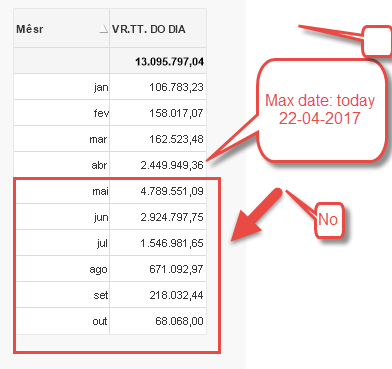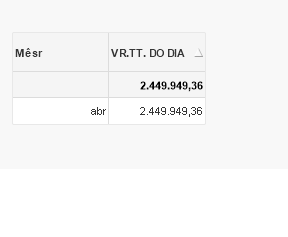Unlock a world of possibilities! Login now and discover the exclusive benefits awaiting you.
- Qlik Community
- :
- All Forums
- :
- QlikView App Dev
- :
- I NEED TO FILTER YEAR CURRENT UP TO THE CURRENT MO...
- Subscribe to RSS Feed
- Mark Topic as New
- Mark Topic as Read
- Float this Topic for Current User
- Bookmark
- Subscribe
- Mute
- Printer Friendly Page
- Mark as New
- Bookmark
- Subscribe
- Mute
- Subscribe to RSS Feed
- Permalink
- Report Inappropriate Content
I NEED TO FILTER YEAR CURRENT UP TO THE CURRENT MONTH
Returns me due date to date today: It's OK
Sum({$<Anor ={$(=Year(today()))}, Mêsr={$(=Month(today()))}, Diar={'<=$(=Day(Today()))'} >} VALOR_EMIS_NOVO_REC)
I need you to bring me to the current month.?
Example:
Month Valor
Abr 125.000,00
Mar 854.000.00
Fev 822.000,00
Jan 322.000.00
Example set analysis: It's OK
Sum({$<Anor ={$(=Year(today()))}, Mêsr={$(=Month(today()))}, Diar={'<=$(=Day(Today()))'} >} VALOR_EMIS_NOVO_REC)

- Tags:
- qlikview_scripting
- Mark as New
- Bookmark
- Subscribe
- Mute
- Subscribe to RSS Feed
- Permalink
- Report Inappropriate Content
From this data set.
Example:
Month Valor
Abr 125.000,00
Mar 854.000.00
Fev 822.000,00
Jan 322.000.00
Are you expecting this?
Abr 125.000,00
- Mark as New
- Bookmark
- Subscribe
- Mute
- Subscribe to RSS Feed
- Permalink
- Report Inappropriate Content
So you want the full month? then remove the day part of set analysis
Sum({$<Anor ={$(=Year(today()))}, Mêsr={$(=Month(today()))}, Diar={'<=$(=Day(Today()))'} >} VALOR_EMIS_NOVO_REC)
and use just this
Sum({$<Anor ={$(=Year(today()))}, Mêsr={$(=Month(today()))}>} VALOR_EMIS_NOVO_REC)
or if you want only till March, then
Sum({$<Anor ={$(=Year(today()))}, Mêsr={"<$(=Month(today()))"}>} VALOR_EMIS_NOVO_REC)
If a post helps to resolve your issue, please accept it as a Solution.
- Mark as New
- Bookmark
- Subscribe
- Mute
- Subscribe to RSS Feed
- Permalink
- Report Inappropriate Content
Preciso do corrente ano, até o mês atual, até o dia atual,.
That is the date until today
A data tem continuidade, mais do que o mês e hoje
Exemplo:

NÃO,
Sum ({$ <Anor = {$ (= Ano (hoje ()))}, MESR = {$ (= mês (hoje ()))}
>} VALOR_EMIS_NOVO_REC)

- Mark as New
- Bookmark
- Subscribe
- Mute
- Subscribe to RSS Feed
- Permalink
- Report Inappropriate Content
ok, Please post some sample data
If a post helps to resolve your issue, please accept it as a Solution.
- Mark as New
- Bookmark
- Subscribe
- Mute
- Subscribe to RSS Feed
- Permalink
- Report Inappropriate Content
Example attachment
- Mark as New
- Bookmark
- Subscribe
- Mute
- Subscribe to RSS Feed
- Permalink
- Report Inappropriate Content
May be use this in your expression
CalendarDater = {"<=$(=Date(Today(), 'DD-MMM-YYYY'))"}
- Mark as New
- Bookmark
- Subscribe
- Mute
- Subscribe to RSS Feed
- Permalink
- Report Inappropriate Content
Did not work